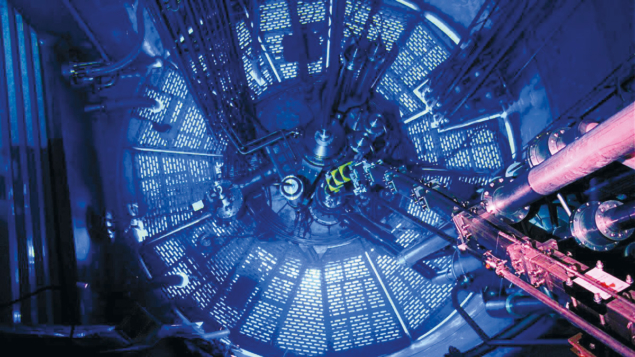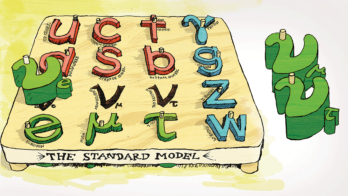
The STEREO experiment, located at the high-flux research reactor at the Institut Laue-Langevin (ILL), Grenoble, is the latest to cast doubt on the existence of an additional, sterile neutrino state. Based on the full dataset collated from October 2017 until the experiment shut down in November 2020, the results support the conclusions of a global analysis of all neutrino data, that a normalisation bias in the beta-decay spectrum of 235U is the most probable explanation for a deficit of electron neutrinos seen at reactor experiments during the past decade.
The confirmation of neutrino oscillations 25 years ago showed that the lepton content of a given neutrino evolves as it propagates, generating a change of flavour. Numerous experiments based on solar, atmospheric, accelerator, reactor and geological neutrino sources have determined the oscillation parameters in detail, reaffirming the three-neutrino picture obtained by precise measurements of the Z boson’s decay width at LEP. However, several anomalies have also shown up, one of the most prominent being the so-called reactor antineutrino anomaly. Following a re-evaluation of the expected νe flux from nuclear reactors by a team at CEA and Subatech in 2011, a deficit in the number of νe detected by reactor neutrino experiments appeared. Combined with a longstanding anomaly reported by short-baseline accelerator-neutrino experiments such as LSND and a deficit in νe seen in calibration data for the solar-neutrino detectors GALLEX and SAGE, excitement grew that an additional neutrino state – a sterile or right-handed neutrino with non-standard interactions that arises in many extensions of the Standard Model – might be at play.
We anticipate that this result will allow progress towards finer tests of the fundamental properties of neutrinos
Designed specifically to investigate the sterile-neutrino hypothesis, STEREO was positioned about 10 m from the ILL reactor core to measure the evolution of the antineutrino energy spectrum from 235U fission at short distances with high precision. Comprising six cells filled with gadolinium-doped liquid scintillator positioned at different distances from the reactor core, producing six spectra, the setup allows the hypothesis that νe undergo a fast oscillation into a sterile neutrino to be tested independently of the predicted shape of the emitted νe spectrum.
The measured antineutrino energy spectrum, based on 107,558 detected antineutrinos, suggests that the previously reported anomalies originate from biases in the nuclear experimental data used for the predictions, while rejecting the hypothesis of a light sterile neutrino with a mass of about 1 eV. “Our result supports the neutrino content of the Standard Model and establishes a new reference for the 235U antineutrino energy spectrum,” writes the team. “We anticipate that this result will allow progress towards finer tests of the fundamental properties of neutrinos but also to benchmark models and nuclear data of interest for reactor physics and for observations of astrophysical or geoneutrinos.”
Gallium remains
STEREO’s findings fit those reported recently by other neutrino-oscillation experiments. A 2021 analysis by the MicroBooNE collaboration at Fermilab, for example, favoured the Standard Model over an anomalous signal seen by its nearby experiment MiniBooNE, assuming the latter was due to the existence of a non-standard neutrino. Yet the story of the sterile neutrino is not over. In 2022, new results from the Baksan Experiment on Sterile Transitions (BEST) further confirmed the deficit in the νe flux emitted from radioactive sources as seen by the SAGE and GALLEX experiments – the so-called gallium anomaly – which, if interpreted in the context of neutrino oscillations, is consistent with νe → νs oscillations with a relatively large squared mass difference and mixing angle.
“Under the sterile neutrino hypothesis, a signal in MicroBooNE, MiniBooNE or LSND would require the sterile neutrino to mix with both νe and νμ, whereas for the gallium anomaly, mixing with νe alone is sufficient,” explains theorist Joachim Kopp of CERN. “Even though the reactor anomaly seems to be resolved, we’d still like to understand what’s behind the others.”
Further reading
STEREO Collab. 2023 Nature 613 257.
A Letourneau et al. 2023 Phys. Rev. Lett. 130 021801.
MicroBooNE Collab. 2023 Phys. Rev. Lett. 130 011801.





